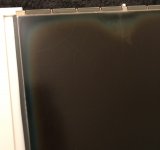In the sign business, I've had to remove every adhesive know to man < /hyperbole > from almost any surface imaginable. Luckily, glass is probably the easiest one to clean! Here are a few examples of cleaning agents I've used.
YMMV!!!!!!!!!!
Vinegar is a great glass cleaner and is good for dissolving some types of adhesives used for stickers.
If the adhesive is oil based, turpentine is a great cleaning agent. If you opt for less expensive "mineral spirits" be careful about what's in it. It's a generic term for just about anything they wanna throw in there. Benzene (lighter fluid) has been used in it. Use only outdoors.
That said, Benzine/Lighter Fluid is an awesome cleaning agent.
Definitely use it outdoors, preferably in a light breeze!
You could try good ole WD-40, dunno what's in that offhand, but it's mostly volitiles that flash off for
Water
Displacement. It's not all that much of a lubricant unless it's in light duty, low cycle, low pressure applications. Now WD-40's a brand name and they make plenty great lubricants for all sorts of uses. The volatiles in the classic
multi-use product make it a great cleaning agent leaving very little residue.
As a next to last resort, I'd try Goof-Off. It's made specifically for removal of all kinds of cruddy glue glop. That stuff smells horrible!
Last resort would be oven cleaner, it's fabulous for removing vinyl adhesives from the baked enamel surfaces of vehicles without damage.
A single edge razor blade won't harm the glass, especially with any of the above or just plain water lubricating its surface. Use it on a low angle as in a "scraper" but use your hand carefully as the holder for better control. GREAT for corralling glop into a pile, onto itself alone and better with a thin piece of cardboard used as a backstop.
YMMV!!!!!!!!!!




